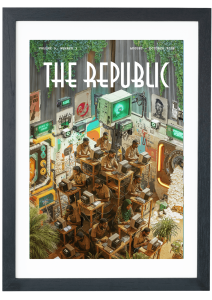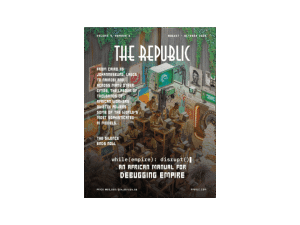
Photo illustration by Dami Mojid / THE REPUBLIC.
THE MINISTRY OF WORLD AFFAIRS
The Development Zone That Never Was?

Photo illustration by Dami Mojid / THE REPUBLIC.
THE MINISTRY OF WORLD AFFAIRS
The Development Zone That Never Was?
On 12 July 2025 the small twin-island state of São Tomé and Príncipe—comprising just 210,000 inhabitants as of 2024—celebrates its 50th independence anniversary since Portuguese rule. The hitherto uninhabited islands in the Gulf of Guinea were colonized by the Portuguese starting from 1493 by white settlers and enslaved Africans from the Kingdom of Benin, followed subsequently by enslaved people from the Kingdom of Kongo and Angola. The resulting genetic and cultural mixing among the different groups brought forth the archipelago’s distinct African Creole society with its own culture and language.
In his speech on Independence Day in 1975, the country’s first president, Manuel Pinto da Costa (1975–1990), declared that the São Toméans had achieved this historic and decisive stage because five centuries of colonial domination and oppression had not succeeded in breaking either their will nor determination to live freely and independently. The liberation struggle, he said, would be meaningless if São Toméans did not use the independence to definitively eliminate poverty, misery, unemployment, disease and ignorance, as well as an end to the evils inherited from the fascist colonial system. The independent state inherited from the Portuguese was characterized by a plantation economy based on cocoa monoculture. In fact, in the 16th century, São Tomé emerged as the first tropical plantation economy based on African slave labour and sugar monoculture. The plantation economy disappeared gradually in the 17th century when São Tomé was displaced by Brazil’s emerging plantation economy where the sugar produced was of much better quality. In São Tomé and Príncipe, the plantation economy was only re-established in the 19th century when the Portuguese introduced new cash crops from Brazil, coffee and cocoa. Initially coffee was the major cash crop but by the end of the 19th century, cocoa was by far the main export product.
50 years on, much has indisputably changed and improved in São Tomé and Príncipe. Independence and sovereignty have created new opportunities in international relations and cooperation with other nations in Africa and beyond—with São Tomé’s current bilateral partners including China, Portugal, Angola, Brazil, Nigeria, India, Japan, France, Turkey, Russia, Equatorial Guinea, Rwanda, Morocco, Cabo Verde, Serbia and the USA. But 50 years of independence have not been sufficient for eliminating misery, poverty, unemployment or disease. Despite a rising Human Development Index from 0.45 in 1990 to 0.63 in 2019, three-quarters of the population currently live below the poverty line. For decades, the country has been heavily dependent on foreign assistance, with over 90 per cent of the country’s public investment projects financed by external partners. Due to a lack of employment opportunities and economic prospects at home, emigration has in recent years become significant and increasing, mostly to Portugal, where 52 per cent of the migrants reside. Migrants to Portugal increased from 7,837 in 2021 to 19,702 in 2023.
Besides Manuel Pinto da Costa (born in 1937), three ministers of São Tomé’s first ten-member national government of 1975 are still alive: Prime Minister and Minister of Foreign Affairs and Defence Miguel Trovoada (1936), Minister of Economic Coordination Leonel Mário d’Alva (1935), and Minister of Internal Administration Daniel Daio (1947). Compared with the current situation in their country, at the time, they clearly had other future expectations. Like the other four former Portuguese colonies in Africa, at independence, they established a socialist one-party state based on the Soviet example. The socialist regime nationalized the Portuguese-owned plantations without compensation and tried to diversify the economy. Soon after independence, the one-party regime was affected by internal strife, while the leadership of Pinto da Costa became increasingly autocratic.
When the socialist regime proved to be a political and socioeconomic failure, Pinto da Costa accepted the introduction of multiparty democracy in 1990. At the time, his three former companions had either been expelled or had abandoned the regime; and after 1990 belonged to different political parties. The democratic transition brought civil and political rights, a free-market economy, and various Western providers of foreign assistance. (In the Ibrahim Index of African Governance 2023, São Tomé and Príncipe is ranked 12th, while, for comparison, Nigeria is rated 33rd out of 54 countries.) However, the system change failed to bring significant socioeconomic development and a concurrent reduction of external dependence. Despite consecutive agricultural reforms, the country failed to increase cocoa output or diversify agricultural exports, while the development of tourism lagged significantly behind expectations.
FROM HIGH HOPES TO DISILLUSIONMENT
In 1997 a rosy economic future appeared on the horizon when São Tomé and Príncipe signed its first oil exploration contract with the Environmental Remediation Holding Corporation (ERHC), a small unknown US company. In 1998 and 2001 the government signed two other contracts on seismic surveys in its territorial waters with ExxonMobil and the Norwegian company Petroleum Geo-Services (PGS) respectively. In 2001, Nigerian business tycoon Emeka Offor took over a majority stake in ERHC and renamed the company ERHC Energy.
Meanwhile, São Tomé and Príncipe had signed agreements with Equatorial Guinea and Gabon on the delimitation of the common maritime borders. The negotiations with Nigeria on such an agreement failed, since the two governments failed to agree on the terms of delimitations. Consequently, in February 2001, Abuja and São Tomé signed a 45-year treaty on the establishment of a 34,548 km²-large Joint Development Zone (JDZ) in the disputed maritime area, where expenditures and profits would be divided in a ratio of 60 per cent and 40 per cent between Nigeria and São Tomé and Príncipe respectively.
According to the treaty, the JDZ would be managed by a Joint Development Authority (JDA) headquartered in Abuja. The JDA would be headed by two directors each from São Tomé and Nigeria and supervised by a Joint Ministerial Council, comprised of four government ministers from each country. At the time in São Tomé and Príncipe, oil appeared to be a panacea to overcome poverty and aid dependency in a short period of time. The fact that all neighbouring countries in the Gulf of Guinea region were already oil producers reinforced such optimistic expectations. The new partnership with Nigeria was expected to become crucial for the archipelago’s development.
But from the start, São Tomé’s three oil agreements were enmeshed in suspicions of irregularities, a lack of transparency, and excessive concessions in favour of ERHC, ExxonMobil and PGS, granted in return for their support in the development of the archipelago’s oil sector. In 2003, São Tomé consequently renegotiated the terms of the three agreements, instigated by the International Monetary Fund (IMF). Under the new agreement, ERHC Energy received working interests ranging from 15 to 30 per cent in six blocks of the JDZ. Four of these blocks were exempted from the payment of signature bonuses. In addition, ERHC Energy received preferential option rights for two blocks in São Tomé’s Exclusive Economic Zone (EEZ). The renegotiated agreements paved the way for the first licensing round for nine blocks in the JDZ. Optimistic estimates of oil reserves in the nine blocks ranged from six to eleven billion barrels of crude oil. The JDA set the minimum bid per block at $30 million.
shop the republic
In October 2003 in São Tomé, the bids were publicly opened. 20 oil companies submitted valid bids for seven blocks. Chevron offered the highest bid of $125 million for Block 1, considered the most promising acreage. The highest bids for the seven blocks totalled $500 million, generating a mood of great enthusiasm. However, in April 2004, the JDA only awarded exploration rights for Block 1 jointly to ChevronTexaco (51 per cent), ExxonMobil (40 per cent) and Dangote Equity Energy Resources (9 per cent). Five blocks were put in another auction held in December that year, since the two governments did not trust the financial and technical capacities of many largely unknown bidding companies. The remaining three blocks were withdrawn from the licensing round. In April 2005 the JDA awarded blocks 2–6 to different consortiums of largely unknown oil companies.
Since December 2004, the JDA has not held any other licensing round. Notwithstanding this, between 2004 and 2017 the JDA maintained an average annual budget of $10.9 million. Block ownership in the JDZ has changed several times after other oil companies acquired majority shares from previous license holders. Consecutive exploration drillings carried out in Blocks 1–4 between 2006 and 2013 failed to discover commercially viable oil reserves. As a result, oil companies Chevron, ExxonMobil, Sinopec and Total, consecutively abandoned the JDZ. While the current license holders of Block 1 failed to conduct exploration works, the JDA failed to attract new investors to Blocks 2–4, where ERHC Energy has remained the only shareholder. However, in 2019, TotalEnergies returned to the JDZ, signing a production-sharing contract for Blocks 7, 8 and 11 in exchange for a signature bonus of $5 million. The new hope did not last long because in 2024, TotalEnergies exited the JDZ for the second time after seismic surveys carried out in the acreage failed to prove the existence of commercially viable hydrocarbons. While the whole JDZ has become a dry hole, significant developments of non-hydrocarbon resources in the zone have not been reported either.
shop the republic
PROSPECTS BEYOND THE JDZ
While the moribund JDZ faces an uncertain future, there are still prospects for São Tomé’s EEZ, at least for the time being. In 2004 the country set up a National Oil Agency (Agência Nacional de Petróleo; ANP) to manage the 125,891 km²-large EEZ. The first licensing round for seven of 19 EEZ blocks held in 2010 proved to be a failure because only Block 3 was adjudicated to the Nigerian company, Oranto Petroleum (now Atlas Oranto Petroleum International Limited). Until 2019 the ANP directly awarded another nine blocks to different oil companies. As in the JDZ, block ownership in the EEZ has changed repeatedly, including that of the two blocks once awarded to ERHC Energy. Since 2019, Royal Dutch Shell has been the major investor in the EEZ. In 2022, the company conducted exploratory drilling in Block 6. As the results were not conclusive, in 2024, Shell announced additional exploratory drillings in Block 10 (which is adjacent to Block 6) set for mid-2025.
The 2002 treaty on the Joint Petroleum Development Area (JPDA) between Australia and Timor-Leste stands out as a similar bilateral agreement between two unequal partners. After having restored its independence, the small island state of Timor-Leste, a former Portuguese colony, signed a treaty with neighbouring Australia to allow hydrocarbon exploration within their unsettled maritime borders in the Timor Sea. It ceased to exist in August 2019 when the Australia-Timor-Leste Maritime Boundary Treaty entered into force. In contrast to the JDZ, the JPDA produced oil and generated significant revenue for Timor-Leste.
shop the republic
-
‘The Empire Hacks Back’ by Olalekan Jeyifous by Olalekan Jeyifous
₦70,000.00 – ₦75,000.00Price range: ₦70,000.00 through ₦75,000.00 This product has multiple variants. The options may be chosen on the product page -
‘Make the World Burn Again’ by Edel Rodriguez by Edel Rodriguez
₦70,000.00 – ₦75,000.00Price range: ₦70,000.00 through ₦75,000.00 This product has multiple variants. The options may be chosen on the product page -
‘Nigerian Theatre’ Print by Shalom Ojo
₦150,000.00 -
‘Natural Synthesis’ Print by Diana Ejaita
₦70,000.00 – ₦75,000.00Price range: ₦70,000.00 through ₦75,000.00 This product has multiple variants. The options may be chosen on the product page
shop the republic
In the beginning, oil companies, rulers from both countries, and international organizations alike believed in the highly optimistic oil production forecast for the JDZ. Irrespective of the consecutive setbacks in the JDZ, in July 2013, the IMF in its country report predicted São Tomé’s GDP growth to increase sevenfold from 5.5 per cent in 2014 to 38.7 per cent in 2015 due to oil production in the JDZ. However, this has long proven to be sheer wishful thinking. Given the failure of the JDZ, Abuja and São Tomé are likely to look for other opportunities to enhance bilateral cooperation. While São Tomé and Príncipe is a member of the Economic Community of Central African States, besides Nigeria, the country has recently sought to further diversify its foreign relations by strengthening ties with other ECOWAS member states, including Ghana, Togo, and Cabo Verde. After almost 25 years of existence, the JDZ, once expected to become a promising source of wealth for the two nations, has largely become a white elephant. Contrary to what was hoped in 2001, in 2025, São Tomé and Príncipe does not commemorate 50 years of independence as a fruitful oil producer⎈
BUY THE MAGAZINE AND/OR THE COVER
-
‘Make the World Burn Again’ by Edel Rodriguez by Edel Rodriguez
₦70,000.00 – ₦75,000.00Price range: ₦70,000.00 through ₦75,000.00 This product has multiple variants. The options may be chosen on the product page -
The Republic V9, N2 Who Dey Fear Donald Trump? / Africa In The Era Of Multipolarity
₦40,000.00
















